A quick garden report then we can all get back to doomscrolling. (Here’s a list of solid, experienced relief organizations that can help.)
Another atmospheric river is hitting the Oregon coast, but here in coastal Long Beach we’re climbing into the 80’sF. The plants that bloom off and on throughout the winter, like Passiflora vitifolia, know what to do with that warmth. I was trimming back straggly growth on this vine, which sounds fairly straighforward. But vines are tricky and complicated, and it can be difficult to trace what’s actually being cut. One misplaced snip, and before you know it yards of healthy vine have been severed. If this passiflora were a dainty thing, I’d be more angry with myself. But seeing as I’ve already had to cut an exploratory shoot out of the acacia tree quite a distance away, getting heavy handed with the pruners is not much cause for remorse.
I’ve been simplifying and streamlining the Long Beach garden, resolving not to add any more plants or containers. And that’s holding true with some minor exceptions, like that enormous pot of Lomandra ‘Lucky Stripe’ on the far right. It was a discounted plant I intended to bring back to the Oregon garden to pair with the one already planted there, but changed my mind when I saw how it transformed this area. (If you’re game for more info on the subject than seems reasonable, possible or necessary, it’s provided at the end of this post.)
I’ve planted countless Lophomyrtus x ralphii here in Long Beach and none of them have “stuck.” Maybe a little too dry, a little too crowded. I grabbed a couple ‘Red Dragon’ to trial in the Oregon zone 8b garden, where they’re very borderline (to 20F), but lost my nerve at the prospect of potentially sacrificing both of these gorgeous New Zealander shrubs, and split the difference by keeping one in Long Beach. And that’s the last of any new planting in Long Beach, I swear!
Monocarpic Agave vilmoriniana ‘Stained Glass’ is making plans to leave this earth, sending forth an end-of-the-line bloom stalk which will hopefully become studded with lots of bulbils for new plants. I’m not expecting most of them to be variegated but hoping for just a few with this coloring…
In determining what Long Beach plants might potentially be candidates for the Oregon garden, I’ve run into the limits of memory — which astelia is this? A handy search of this blog tells me it’s Astelia banksii (20-25F). A small piece of it is being rooted for a northern trial, possibly container only so it can be protected in winter.
As promised, more reading on the pot of Lomandra ‘Lucky Stripe,’ the long and short of it:
short version:
- even in small gardens, it helps to go big
- Lomandra ‘Lucky Stripe’ is worth your consideration, waterfalling out of a pot or in the ground. Sun or shade, wet or dry, hardy to 10-15F, 3-4′ x 3-4.’
- I’ll be watching this lomandra in both gardens, coastal Calif zone 10 and coastal Oregon zone 8b.
Long version:
As with all gardens, there is a narrative congestion of memories and stories associated with the simplest gestures like this pot of lomandra. Here’s how this one untangles:
First, the pot. It’s huge, 20 inches tall by 24 inches across. Possibly of Italian origin. I know the owner had his garden fence and gates made by blacksmiths in England, so it’s possible he imported his pots too. (Now most pots available locally are made in either Vietnam or Mexico, very different clay.). It’s actually one of the finest pieces of terracotta I’ve ever owned, rescued from a garden in the process of demolition that once belonged to said owner, an older gentleman who grew many of his plants, including rare magnolias and mackayas, from seed. He told me this during one of my handful of visits to his garden, when I was in my raw, callow 20s. At the time I was uncertain as to how to process this information, whether under “impressed” or “baffled.” I think I filed it away under the latter category. (Trees from seed?! C’mon! Who has that kind of time!?) Very belatedly I realized how sophisticated his garden was, informed by his membership in plant societies and his expertise as an architect. As the neighborhood changed around him and gangs moved in, he understandably became more of a reclusive curmudgeon, and visits dwindled. Decades passed, the gangs aged out of their Jets v. Sharks phase, and one day the house and garden were for sale. All the plants were dug up or trampled, and his precious pots were strewn about the site. I asked the house-flipping team if I could take this one pot, which had the bottom entirely knocked out of it, and they shrugged sure, why not? So there’s that base sedimentary layer of rueful remembrance, gardens passing out of memory, and me as usual picking up what totemic pieces I could drag home. (I don’t necessarily feel anymore that small, personal gardens changing hands is a tragedy. There are a lot worse tragedies, as the past days/years have shown.) I used it as a cache pot for a camellia in a large plastic tub that I’ve been babysitting since the camellia’s owner moved north. Last week a neighbor agreed to rescue the camellia, which faced poor survival odds during our long absences. There seemed no other use for a large, bottomless terracotta pot…or was there? On a hunch that even an empty, bottomless pot, if large enough, would have a calming effect on my overplanted garden, I moved it next to the newly pruned bocconia, backed by the freshly clipped creeping-fig wall. Its smooth mass instantly transformed the space, a glowing beacon against the dark green Ficus pumila.
Second, the plant. Lomandras are grass-like plants from Australia for zones 8-10. ‘Lucky Stripe’ is hardy to 10-15F. It was a freebie from an APLD plant fair. I’ve been watching this lomandra the past three months in the zone 8b Oregon garden and so far it looks very promising. (Though last week it was no doubt challenged by night-time temps in the low 20’sF and some more snow.) Tolerant of a wide array of conditions, it’s even deemed suitable for use in the chronic wet of bioswales. It reads more greenish-yellow when compared to Lomandra ‘Platinum Beauty,’ and the half-inch blades are broader. Tissue culture propagation is unstable, so stocks have been slow to build up. Catching up on browsing local SoCal nurseries, I stumbled on a 3-gallon 50 percent off, so I grabbed another one for the Oregon garden. Absentmindedly dropping it in the empty pot prompted a violent change of heart.
Third, the soil. Part of the cleanup of the Long Beach garden has been thinning out the pots, giving lots of containers and tchotchkes to the neighbors, but zealously collecting and storing all the old potting soil. Old potting soil may not be rich enough for annuals and vegetables, but all that pumice and perlite is just what’s needed for the kind of plants I want to grow in pots up north. A couple trash cans full will fill the stock tanks in the Oregon garden, and the remainder filled this bottomless pot sited in the garden with the newly added lomandra. I count reusing and saving on constantly buying bags and bags of potting soil as a triumph.



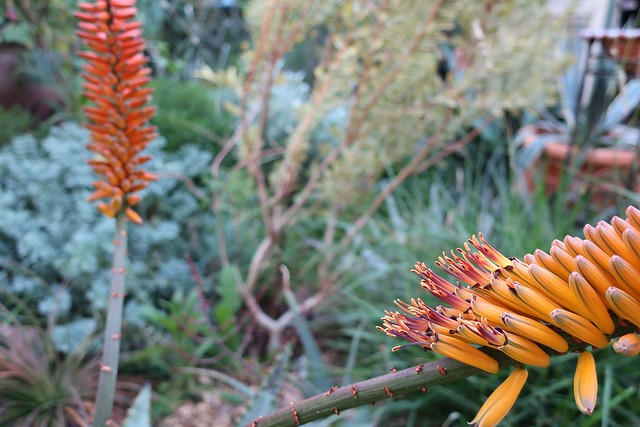

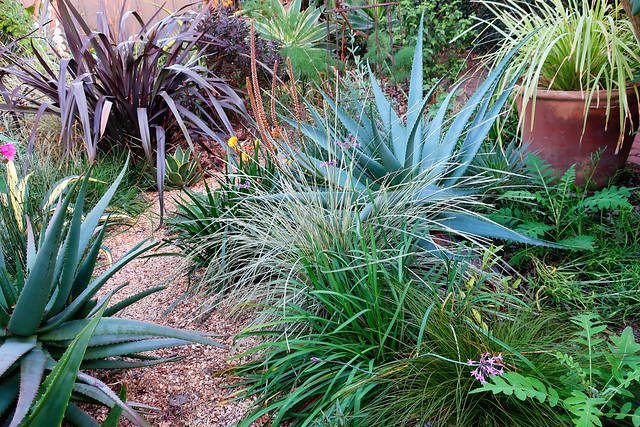
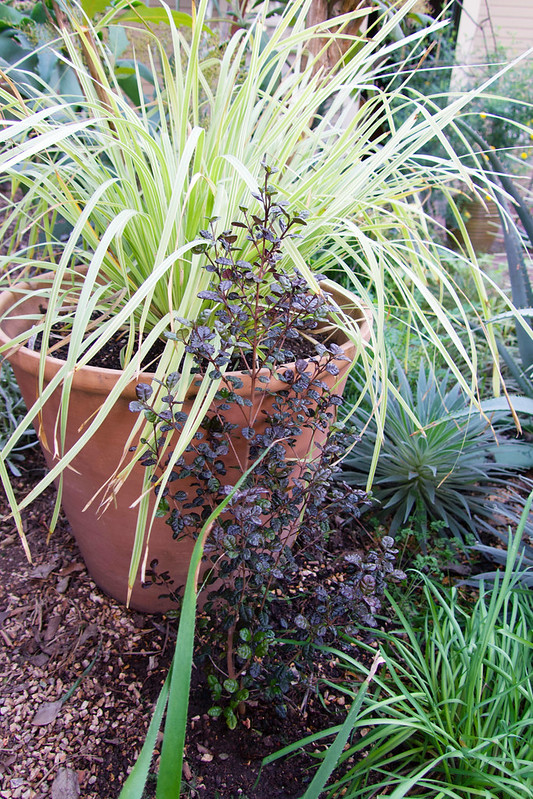



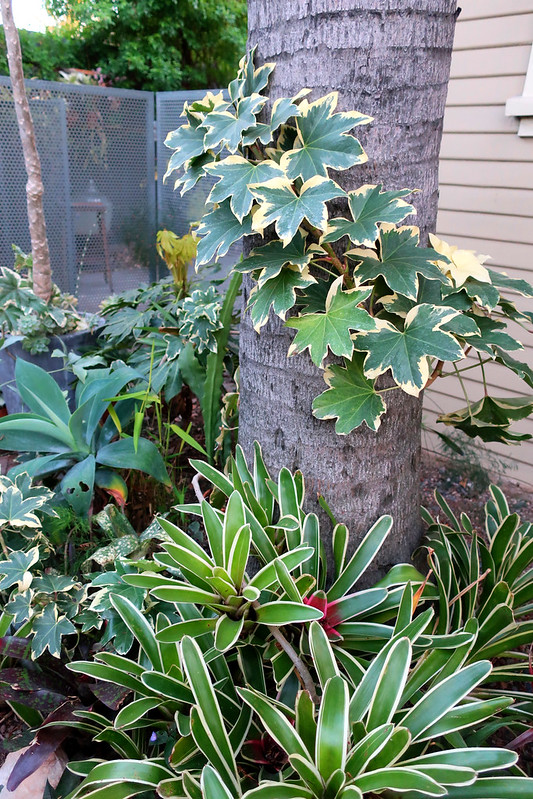

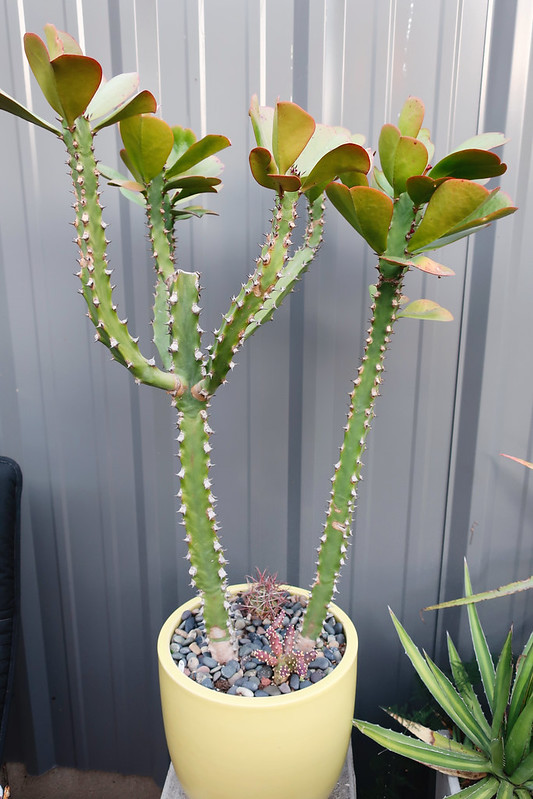
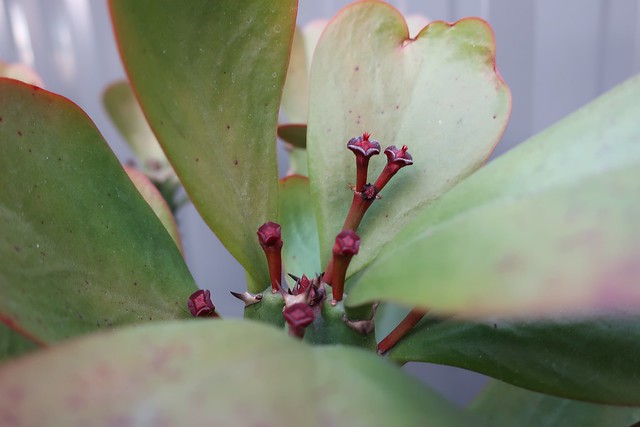




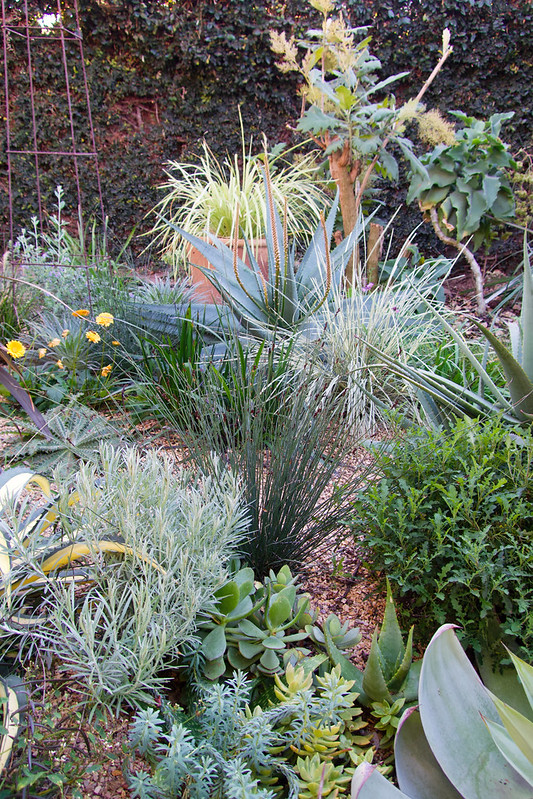

Your garden is looking healthy and happy despite all those months away leaving its care to a tag team of caregivers. Thanks for the introduction to ‘Lucky Stripe’ Lomandra, which is new to me. Thanks as well for the handy list of agencies addressing the current crisis in Ukraine – I’d been feeling too shell-shocked by events to act but seeing the list helped me focus.
So nice to see photos from your garden to redirect my focus, even temporarily.
Your Agave vilmoriniana ‘Stained Glass’ looks so small to be flowering. Mine is huge in comparison. I’m ready for it to flower, though. I want to plant something else in its place.
I’ve never met a lomandra I didn’t like. Will keep an eye open for ‘Lucky Strike’.
@and thanks, Kris, for taking in some of my “strays” like the dombeya!
@Gerhard, that agave has been container grown, so that might have contributed to its small size. But a lot of its wingspan was reduced when it was damaged by various projects, so that’s been a contributor too. So funny that you’re getting impatient for yours to move on!
Lophomyrtus x ralphii is a new name to me, tempting. I hope that your back and forth travels will not keep you from sharing the various stages of your Agave vilmoriniana ‘Stained Glass’ bloom-spike. Maybe a gentle nudge to whomever is caring for the garden in your absences to take photos?
That’s a wonderful story about the bottomless pot. A nice way to honor the gardener who originally owned it.
K’s ‘Stained Glass’ flowered a few years ago. It must have had well over 1,000 bulbils on the stem. I picked 100 of the best to grow and unexpectedly they pretty much all retained their variegation and grew. Now I have 99 spares.
You don’t really have two gardens–you have one that is divided into two very different ones. 🙂
Beautiful garden! Your blog is very informative, thank you for sharing it.